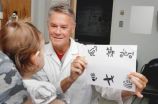(Press-News.org) Failure to get the best treatment and variations in the quality of care are the most likely reasons why survival for blood cancer patients still varies widely between regions within Europe, according to the largest population-based study of survival in European adults to date, published in The Lancet Oncology.
"The good news is that 5-year survival for most cancers of the blood has increased over the past 11 years, most likely reflecting the approval of new targeted drugs in the early 2000s such as rituximab for non-Hodgkin lymphoma and imatinib for chronic myeloid leukaemia", explains study leader Dr Milena Sant from the Fondazione IRCCS Istituto Nazionale dei Tumori in Milan, Italy.*
"But there continue to be persistent differences between regions. For example, the uptake and use of new technologies and effective treatments has been far slower in eastern Europe than other regions. This might have contributed to the large differences in the management and outcomes of patients."*
The EUROCARE study analysed data from 30 cancer registries** covering all patients diagnosed in 20 European countries to compare changes in 5-year survival for more than 560 400 adults (aged 15 years and older) diagnosed with 11 lymphoid and myeloid cancers between 1997 and 2008, and followed up to the end of 2008.
Some blood cancers have shown particularly large increases in survival between 1997 and 2008—eg, follicular lymphoma (59% to 74%), diffuse large B-cell lymphoma (42% to 55%), chronic myeloid leukaemia (32% to 54%), and acute promyelocytic leukaemia (50% to 62%).
The greatest improvements in survival during 1997� have been in northern, central, and eastern Europe, even though adults in eastern Europe (where survival in 1997 was the lowest) continue to have lower survival for most blood cancers than elsewhere.
But survival gains have been lower in southern Europe and the UK. For example, improvements in 5-year chronic myeloid leukaemia survival in northern (29% to 60%) and central Europe (34% to 65%) have been persistently higher than in the UK (35% to 56%) and southern Europe (37% to 55%). For more detailed findings for all cancers by European area see table 4 on page 6 and figure 2 on page 6.
The risk of death within 5 years from diagnosis fell significantly for all malignancies except myelodysplastic syndromes between 1997 and 2008. But not all regions have seen such improvements. For example, compared with the UK, the excess risk of death was significantly higher in eastern Europe than in other regions for most of the cancers investigated, but significantly lower in northern Europe. For more detailed findings for all cancers by European area and age see table 5 on page 7.
The authors suggest that the most likely reasons for continuing geographical differences in survival are inequalities in the provision of care and in the availability and use of new treatments.
"We know that rituximab, imatinib, thalidomide, and bortezomib were first made available for general use in Europe in 1997, 2001, 1998, and 2003, respectively. The years following general release of these drugs coincided with large increases in survival for chronic myeloid leukaemia, diffuse large B-cell lymphoma, and follicular lymphoma; with a smaller but still significant survival increase for multiple myeloma plasmacytoma.", say the authors.
However, they point out that uptake and use of these drugs has not been uniform across Europe. For example, market uptake of rituximab, imatinib, and bortezomib was lower in eastern Europe than elsewhere and might explain the consistently lower survival in this region.
According to Sant, "High resolution studies that use clinical records to collect detailed clinical information for representative samples of cancer registry cases can more directly link treatments and clinical characteristics to survival."
Writing in a linked Comment, Alastair Munro from the University of Dundee Medical School in Scotland questions whether these improvements in survival can just be attributed to the drugs, saying that, "Better understanding of the conclusions from EUROCARE-5 requires additional information about changes over time (and space) affecting: survival according to the broad categories of disease (Hodgkin's lymphoma, non-Hodgkin lymphoma, leukaemias,
myeloma, and other myeloid malignancies); the distribution of histological subtypes and their relation with the age distribution of the population; the distribution of stages at diagnosis; and the timing of active intervention for indolent tumours. …When making comparisons, whether across time or space, one should consider the effect of potential confounders. Is it all about the drugs? The answer is, not entirely."
INFORMATION:
Notes to Editors
*Quotes direct from author and cannot be found in text of Article.
**Northern Europe (Denmark, Iceland, and Norway), the UK (England, Northern Ireland, Scotland, and Wales), central Europe (Austria, Côte d'Or haematological, Saarland, Basel, Geneva, Grisons, St Gallen, Valais, and Netherlands), eastern Europe (Bulgaria, Estonia, Lithuania, Kielce, and Slovakia), and southern Europe (Ferrara, Modena, Parma, Ragusa, Romagna, Sassari, Torino, Malta, and Slovenia).
The Lancet Oncology: Differences in treatment likely to be behind differing survival rates for blood cancers between regions within Europe
2014-07-14
ELSE PRESS RELEASES FROM THIS DATE:
MUHC researcher unveils novel treatment for a form of childhood blindness
2014-07-14
This news release is available in French.
Montreal, July 13, 2014 — An international research project, led by the Research Institute of the McGill University Health Centre (RI-MUHC) in Montreal, reports that a new oral medication is showing significant progress in restoring vision to patients with Leber congenital amaurosis (LCA). Until now, this inherited retinal disease that causes visual impairment ranging from reduced vision to complete blindness, has remained untreatable. The study is published today in the scientific journal The Lancet.
"This is the first ...
Australia drying caused by greenhouse gases
2014-07-13
NOAA scientists have developed a new high-resolution climate model that shows southwestern Australia's long-term decline in fall and winter rainfall is caused by increases in manmade greenhouse gas emissions and ozone depletion, according to research published today in Nature Geoscience.
"This new high-resolution climate model is able to simulate regional-scale precipitation with considerably improved accuracy compared to previous generation models," said Tom Delworth, a research scientist at NOAA's Geophysical Fluid Dynamics Laboratory in Princeton, N.J., who helped ...
Deep within spinach leaves, vibrations enhance efficiency of photosynthesis
2014-07-13
ANN ARBOR – Biophysics researchers at the University of Michigan have used short pulses of light to peer into the mechanics of photosynthesis and illuminate the role that molecule vibrations play in the energy conversion process that powers life on our planet.
The findings could potentially help engineers make more efficient solar cells and energy storage systems. They also inject new evidence into an ongoing "quantum biology" debate over exactly how photosynthesis manages to be so efficient.
Through photosynthesis, plants and some bacteria turn sunlight, water and ...
Researchers discover boron 'buckyball'
2014-07-13
PROVIDENCE, R.I. (Brown University) -- The discovery 30 years ago of soccer-ball-shaped carbon molecules called buckyballs helped to spur an explosion of nanotechnology research. Now, there appears to be a new ball on the pitch.
Researchers from Brown University, Shanxi University and Tsinghua University in China have shown that a cluster of 40 boron atoms forms a hollow molecular cage similar to a carbon buckyball. It's the first experimental evidence that a boron cage structure—previously only a matter of speculation—does indeed exist.
"This is the first time that ...
Study finds cause of mysterious food allergy, suggests new treatment strategy
2014-07-13
New research in Nature Genetics identifies a novel genetic and molecular pathway in the esophagus that causes eosinophillic esophagitis (EoE), opening up potential new therapeutic strategies for an enigmatic and hard-to-treat food allergy.
EoE is a chronic inflammatory disorder of the esophagus. The condition is triggered by allergic hypersensitivity to certain foods and an over-accumulation in the esophagus of white blood cells called eosinophils (part of the body's immune system). EoE can cause a variety of gastrointestinal complaints including reflux-like symptoms, ...
Antibody halts cancer-related wasting condition
2014-07-13
BOSTON – New research raises the prospect of more effective treatments for cachexia, a profound wasting of fat and muscle occurring in about half of all cancer patients, raising their risk of death, according to scientists from Dana-Farber Cancer Institute.
Many strategies have been tried to reverse the condition, which may cause such frailty that patients can't endure potentially life-saving treatments, but none have had great success.
Scientists reporting in the July 13 advanced online edition of Nature, led by Bruce Spiegelman, PhD, demonstrated that in mice bearing ...
Stanford researchers invent nanotech microchip to diagnose type-1 diabetes
2014-07-13
An inexpensive, portable, microchip-based test for diagnosing type-1 diabetes could improve patient care worldwide and help researchers better understand the disease, according to the device's inventors at the Stanford University School of Medicine.
Described in a paper to be published online July 13 in Nature Medicine, the test employs nanotechnology to detect type-1 diabetes outside hospital settings. The handheld microchips distinguish between the two main forms of diabetes mellitus, which are both characterized by high blood-sugar levels but have different causes ...
Study of noninvasive retinal imaging device presented at Alzheimer's conference
2014-07-13
LOS ANGELES – A noninvasive optical imaging device developed at Cedars-Sinai can provide early detection of changes that later occur in the brain and are a classic sign of Alzheimer's disease, according to preliminary results from investigators conducting a clinical trial in Australia.
The researchers will present their findings July 15 in an oral presentation at the Alzheimer's Association International Conference 2014 in Copenhagen, Denmark. They also were invited by conference organizers to participate in a "breaking news" news conference beginning at 7:30 a.m. Sunday, ...
Smell and eye tests show potential to detect Alzheimer's early
2014-07-13
COPENHAGEN, July 13, 2014 – A decreased ability to identify odors might indicate the development of cognitive impairment and Alzheimer's disease, while examinations of the eye could indicate the build-up of beta-amyloid, a protein associated with Alzheimer's, in the brain, according to the results of four research trials reported today at the Alzheimer's Association International Conference® 2014 (AAIC® 2014) in Copenhagen.
In two of the studies, the decreased ability to identify odors was significantly associated with loss of brain cell function and progression to Alzheimer's ...
Brain activity in sex addiction mirrors that of drug addiction
2014-07-11
Pornography triggers brain activity in people with compulsive sexual behaviour – known commonly as sex addiction – similar to that triggered by drugs in the brains of drug addicts, according to a University of Cambridge study published in the journal PLOS ONE. However, the researchers caution that this does not necessarily mean that pornography itself is addictive.
Although precise estimates are unknown, previous studies have suggested that as many as one in 25 adults is affected by compulsive sexual behaviour, an obsession with sexual thoughts, feelings or behaviour ...


